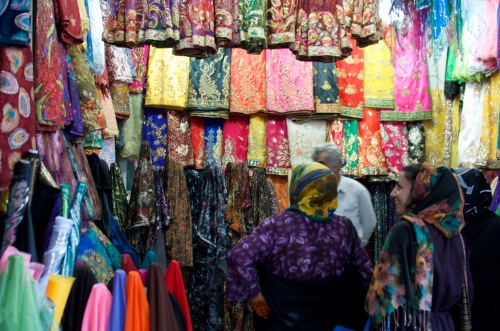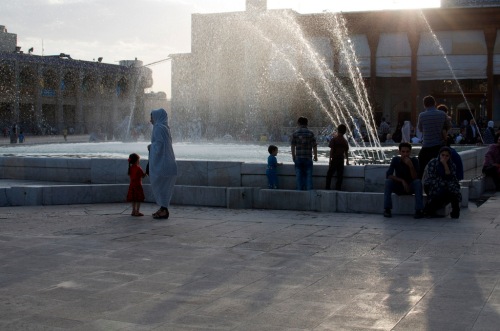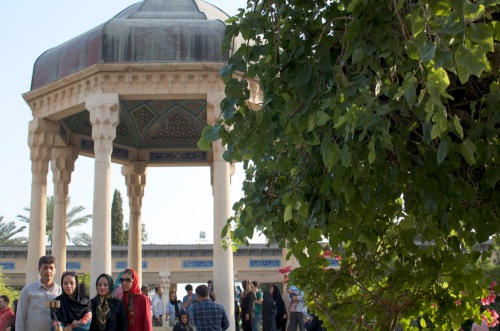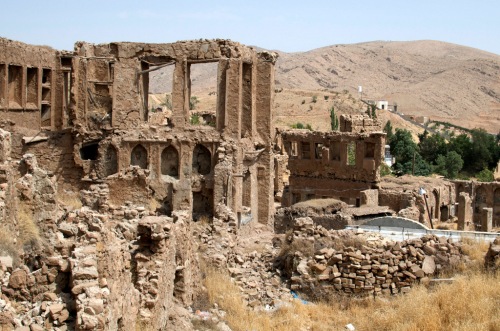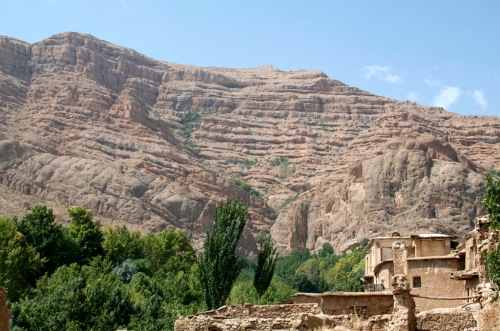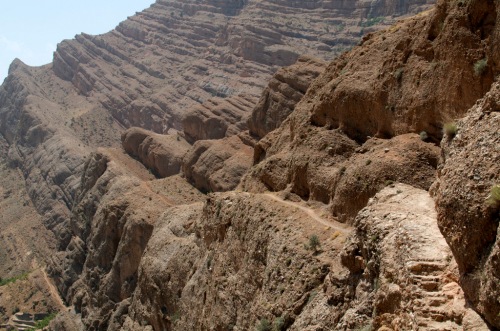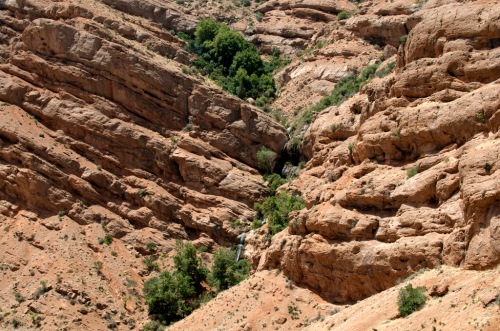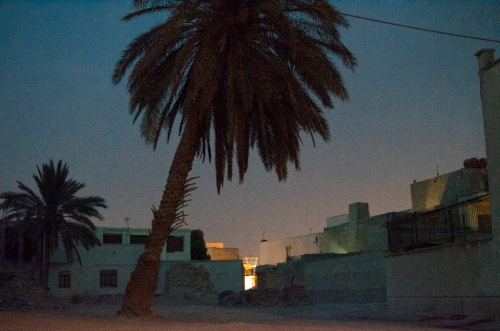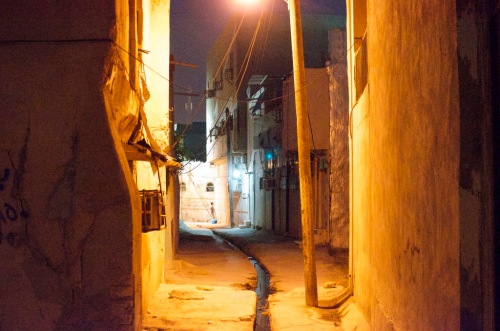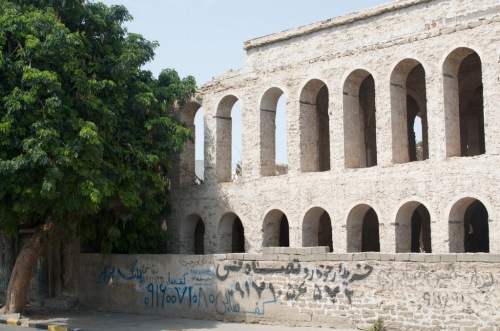From the Persian Heartland to the Gulf
The word “Shiraz” conjures up all sort of delightful associations: wine and poetry and rose gardens (the latter inexplicably, since orange groves are more the thing) leap unbidden into my head at the name of Iran’s southernmost major city. The first is due to the city’s importance as a wine production centre from the 9th to the 19th century—clearly a business that has dried up (and not, in any case, connected to the modern Shiraz grape varietal)—and the second stems from Shiraz’s status as the hometown of two of Iran’s most celebrated poets, Hafez and Saadi, who are both commemorated with large shrines on the northern banks of the Roodkhaneye Khoshk (a seasonal river). Nowadays, Shiraz—the capital of Fars province, the country’s Persian heartland—is better known for its friendly, relaxed inhabitants; many Iranians I meet in other cities tell me they like Shiraz, and Shirazis, best.
The historic centre of the city clusters around the castle of Karim Khan, founder of the 18th century’s short-lived Zand dynasty. One turret of the “Arg” is charmingly askew, as if knocked out of whack by an earthquake. Nearby, a warren of bazaars—reputed to be one of Iran’s finest—stocks spices and miniatures and fabrics and cosmetics and carpets and any number of other trinkets and necessities. A little further off, the Nizam al-Molk mosque is a particularly beautiful specimen of Persian Islamic architecture, with somewhat unusual pink floral tiling and stained glass windows that cast colored light into an exquisite columned prayer hall, to the delight of tourists.
Pretty as that light display is, it’s got nothing on the Shah Cheragh—a shrine at the center of Shiraz that is, as my host Bahram says, a “must” in the city (road signs from as far as 30km away signpost not Shiraz, but the Shah Cheragh). The shrine, Shiraz’s holiest pilgrimage site, houses the tomb of two Shia brothers who fled to the city to escape persecution in around 900 AD. Within the large religious complex, the inner sanctum is entirely upholstered in small, mirrored tiles, which tessellate in patterns across the walls, bouncing shimmering light and glowing a beguiling green near the tomb. At the women’s entrance, smiling girls wrap me up in chador before beckoning me to sit and wait. I watch as other women enter and are offered wet-wipes; each cheerfully smears the heavy makeup from her face before she is allowed in.
Despite this austerity, the Shah Cheragh seems to be engaging in a charm offensive of sorts. Lonely Planet’s latest Iran offering (2012 edition), which is almost entirely incorrect about almost everything, advises that foreigners are not usually allowed access to the shrine. Now, however, there’s an International Affairs office catering to our every need. I am shown around by a very sweet young English-speaking woman (“Thank you for wearing chador and respecting my culture,” she whispers, earnestly, as if the get-up were my idea), who offers fun and interesting facts about the shrine. She expounds on typical Iranian decorative motifs and the significance of the mirrored tiling, is careful to be relatable (“When we pray it’s like yoga, we need to concentrate”), and even allows me to photograph near the tomb—generally forbidden in Iranian shrines.
At the end of our tour, my new friend invites me to hang out in the office. When I decline, she nods her understanding and scurries off, bringing back gifts: a much-appreciated bottle of cold water, a card from International Affairs wishing me a pleasant trip “in the name of God,” and a missive from the current Supreme Leader to the Youth in Europe and North America. The “Letter4U” is signed 21st Jan 2015 and rails against Western governments’ “insincere and hypocritical treatment of other nations,” exhorting the youthful reader not to believe anti-Islamic propaganda but rather to start Quranic studies.
I slip out, past the women milling in their pastel patterned sheets, and immediately purchase an ice cream (an hour prior to iftar), just to emphasize that, in terms of an impending Islamic conversion, I’m a hopeless case. Happily munching the chewy traditional bastani—mixed layers of saffron and vanilla and chocolate, sprinkled with pistachios—I walk slowly towards the sun, which is currently disappearing in a pink-orange puff of cloud.
Despite the disco-ball fabulousness of the Shah Cheragh, the real reason most foreigners visit Shiraz is to use the city as a base from which to reach Persepolis. The ancient complex, known in Iran as Takht-e-Jamshid and once housing the ceremonial capital of the powerful Achaemenid Empire, is situated an hour or so outside of Shiraz. Getting to the remote site via public transport is a little tricky, but I was lucky enough to meet a group of Iranians who offered to take me along with them. Mehdi and Mehran had travelled down from Tehran for the weekend, so that Mehdi could spend time (covertly) with his Shiraz-based girlfriend, Roya. Although the couple (in their mid- to late-20s) speak frequently and enthusiastically of their plans for a future together, their parents remain blissfully ignorant of the relationship.
Blasting modern and traditional Persian dance music, we made our way, past camels patiently waiting for curious tourist to pay for a ride, to the gates of Persepolis. As we wandered the ruins, pooling our knowledge about the significance of the elaborate friezes and the monumental architecture (now charmingly etched with the names of tourists from preceding centuries), Mehran speaks of the difficulties of life in contemporary Iran: the choice he feels compelled to make between breaking with his culture and traditions by fleeing to a new life elsewhere, or staying put in Iran, and trying to raise his children to think outside the limitations of the Islamic Republic.
In an appropriate-feeling interlude, we bump into a mountainous Greek man I had met in Yazd—echoes of Alexander, who, legend has it, razed the opulent palaces of Persepolis in a drunken rage. As we stand near the tomb of a king, on the hill above the ruined city, my companions tell me of the aspirations of the last Shah—who used Persepolis as the setting for a lavish entertainment, celebrating the Persian monarchy’s 2500th anniversary by harking back to the country’s glorious pre-Islamic past in a bid to boost Iran’s national pride and international reputation—and of the subsequent unrest and eventual hijacking of the Revolution. In the midday sun, layers of the country’s history and identity are contained (or projected) onto the weathered stone.
But I am staying far from the ancient, or even revolutionary, past, in Shiraz’s modern northern suburb of Maliabad. Up here, children play soccer in the afternoons, teenagers flock in gangs to large malls, and mothers pick up groceries from a discount produce market. Suburban life chugs on, much like anywhere else in the world.
Perhaps, though, the pre-Islamic past is not so distant. Having previously celebrated Eid al-Fitr (the holiday to mark the end of Ramazan) in Turkey, I expected the event to be a similarly big deal here—but Bahram quickly disillusions me. “We’re not really a Muslim country,” he tells me, in comments echoed by other young Iranians, in other contexts. Of course Bahram, well educated, intellectually curious, and eminently secular, is hardly representative of Iranian society at large. But it’s true that public celebration of Eid seems muted compared to the explosive revelry I experienced in Diyarbakir. In Iran, Nowruz, the Persian new year, celebrated since well before the Arab conquest and rooted in the country’s ancient Zoroastrian past, is biggest national festivity.
Nevertheless, the city’s parks are crowded with picnickers, pashmak (candyfloss) vendors trudging up and down, clouds of pale spun sugar billowing behind them. The sweet-smoky scent of qalyan coils through the trees as Shirazis recline in the shade, finally able to fully relax in public after a month of mandated abstinence. Many take the opportunity to pay their respects to Hafez (whose beautiful verses are often somewhat risqué, involving much exultation of wine and women), and the poet’s shrine—a pleasant, colonnaded courtyard surrounded by shaded gardens—is packed with devotees.
Picnicking is one of the Iran’s treasured national pastimes, and now that Ramazan is over the country’s citizens can properly dedicate themselves to its pursuit (although, frankly, Iranians seem happy to picnic in the most unlikely circumstance—on traffic islands, right next to highways, etc.—so effort is not always required). Qalat, a village near Shiraz, is a favored picnic spot, due to its abundant gardens and proximity to the mountains. I make my way there alone one morning, hopping a bus in downtown Shiraz. Bahram tells me that the old town grows Iran’s finest marijuana, and there is some indication of a thriving trade—a cannabis leaf graffito scrawled across on an ancient door, psychedelic signage advertising art galleries, a man in a weed-logo t-shirt aboard the bus—but no sign of actual cultivation, as I pick my way up the narrow alleys, heading for the hills.
Having emerged from the house-line into orchards of fig and pomegranate, I keep heading upwards, onto the scrabbly lower slopes of the mountain. Drawing level with the red-brown buttresses, I begin to traverse. The track is faint but definitely used, dipping in and out of river gullies as it passes above the town. I am hardly in the appropriate attire and at one stage, as I draw near to a group of reclining young men (the only other people around), I manage to get entangled in thorn bushes. Pushing on, which requires some scrambling, I emerge into yet another gully. Reasoning that descent into the orchards and the town must be possible from here, I begin to climb slowly downwards, hijab flapping unhelpfully in the breeze, only to find myself stranded above a precipitous waterfall. Much “Salaaming” later, I manage to attract the attention of several picnickers at the waterfall’s base, who peer up at me in horror and consternation. It becomes apparent that descent is suicidal, and I sheepishly backtrack.
My picnicking interlocutors were mostly, I think, concerned by my precarious position, although they did also ask where my companions were. Others express surprise that I would consider venturing to the village alone at all. Bahram’s cousin Farid and his girlfriend Maliha (another off-the-radar couple) question me incredulously about the trip. Maliha, explaining their reaction, tells me that for Iranians—and especially women—travelling alone is unusual. In fact, she says, hotels will not allow single women to book a room, requiring a male relative to accompany female guests. “Even my mother, 55, must do this!” she says. I recall an outrageous episode in Iran Awakening, a memoir written by Nobel Prize recipient and lawyer Shirin Ebadi, in which the middle-aged Ebadi is halted from going skiing with her children until the police have called her husband to check that the outing has his authorization.
But in Iran, the sheer number of restrictions means some will inevitably be broken. An eloquent demonstration of this comes one evening, when Bahram, Farid, Maliha and I go for a barbecue at a private garden on the fringes of Shiraz. Bahram explains that purchasing land to be used as private oases outside the city limits is a big trend currently among Shirazis eager to escape social constraints and to interact freely. So it is that a month after entering Iran, I take my first sip of contraband alcohol, courtesy of Bahram’s whisky-brewing vegetarian brother. The homemade tipple is essentially a corn-based moonshine, steeped with cinnamon sticks for flavor and rendered “aged” by a dash of caramel colorant. The resulting beverage is surprisingly smooth and drinkable—so much so that I take it straight.
Pulling out of the garden in the early hours of the morning, we pass other revellers: women in high heels and without hijab—their unfastened manteaus flapping to reveal skimpy sparkly-somethings beneath—totter to their cars, bouffant hairstyles ruffled fondly by the breeze.
After nearly a week in Shiraz, it is time to move on. The bus ride south-west, heading for the Persian Gulf and the sleepy, sweaty port town (bandar) of Bushehr, is surprisingly gorgeous: goats pick their way along the side of the highway through rocky hills that cascade down onto scorched yellow plains. Palm trees ruffle their fronds in the wind, and we pass groves heavy with golden bunches of dates. Our bus driver, tanned and Ray-Banned, hugs the center line with disturbing alacrity and unnecessary haste. Soon, we are hurtling through sandscapes—monumental, mountainous terrain that looks oddly like a large quarry, the road cutting harshly through hard-edged dunes. A peacock blue river runs, improbably, along the valley floor: presumably dyed its peculiar shade by the vegetation clustered around it, this is one of the first full rivers I have seen in Iran. As we get closer to Bushehr, the odd camel lopes awkwardly across the sun-bleached dirt.
Emerging from the bus is like stepping fully-clothed into a sauna—or perhaps the sensation is more akin to being nuked in a microwave, I think to myself, before shouldering my pack and heading into town. By the time I find a suitably cheap mosaferkhane and explain the finer points of my passport (my given names invoke confusion—the poor guy at the desk believes me to be a French Christian), it is evening. Walking swiftly to the gulf, I catch sight of the sea just in time for sunset. Bushehris wander desultorily along the promenade, or drape themselves limply over benches facing the horizon. Gentle wafts of hot salt air slap wetly at the assembled crowd. One woman, accompanied by a husband in flowing white robe, is wearing the distinctive Bandari burqa: a sculpted bronze, mask-like niqab obscuring most of her face. Late in the evening, Bushehr’s power fails completely and I pick my way back to the hotel in darkness.
The next morning, my clothes are still damp with sweat. As with all mosaferkhane (Iran’s cheap guesthouses), women must maintain hijab outside of their rooms. The thought of showering and changing in such conditions is exhausting, so I just struggle on the wet clothes and head out into the heavy morning air. As I step outside, my camera lens immediately fogs up. I had heard the Gulf was humid, but this is insane. Within minutes of perambulation, my clothes go from damp to drenched. Sweat leaks into my eyes, the salt stinging and obscuring my vision. Sunglasses slipping inexorably down my nose, I trudge on, aware of drips cascading down my calf, striping my pants darkly with sweat.
The historic district of Bushehr is built on a promontory, and I squelch my way around its fraying edges. This is the first Iranian town that I’ve been to that is both properly inhabited and almost falling apart; it has the damp, decayed look of a humid place, with plants bursting merrily out of walls and stray dogs picking their way forlornly through the damp semi-ruins (admittedly this is the “historic” section). Open drains snake through the old city streets, putrid green slime bubbling up from the sludge. A smell of sulphur prevails. The town, built on marshy land, has historically had no easy access to fresh water—one of the reasons, perhaps, that the British agent representing the East India Company’s interests in the Gulf (when Bushehr was Iran’s major port) rapidly moved his residence to a remote southern suburb.
The bazaar is, as always, a locus of action. Stalls hawk all the usual produce plus branches and buckets of dates dried and fresh, and a type of herb that looks suspiciously like seaweed. Bananas seem more abundant than usual, and fast food outlets ubiquitously offer sambusa (samosa: a relic of the long-standing maritime trade with India perhaps?). In one narrow side street, passers-by cluster around a group of men dealing exclusively in birds. Doves, pigeons, and roosters are for sale, along with one delicate, golden-feathered creature with an odd, spiked tail.
Aside from the market, the streets of Bushehr are basically empty—sweltering quietly in the heat. Shops are shuttered for much of the day, and the town’s most famous restaurant is boarded up. When I venture out for lunch in the hopes of finding some fish, barely a soul is stirring. Finally, a kindly gentleman draws me a map with ‘X’ marking a restaurant—truly finding an open establishment offering food in Bushehr is akin to striking buried treasure.
When I get to the restaurant, dripping after a languid seaside stroll, I am the only customer. But the galiye mahi—a fish stew heavy on the tamarind (India again)—is delicious despite appearances. As the dish emerges, it looks a little as if the fillets have been braised in petroleum, but the broth’s slick black sheen belies its tangy, well-spiced finish. Served with pickles, herbs, rice and bread, it makes a hearty meal, and I munch stolidly, trying to ignore the unoccupied waiters who have gathered to observe the town’s resident Tourist.
Making my way back into the center, the heat and humidity leaving the world shimmering at the edges, I pass a small palm tree with dates lying smushed at its foot. Looking up, in full desert island survival mode, I can’t resist picking a couple. Soon I am waving the branches up and down, looking no doubt like a crazy woman engaged in a lunatic waltz with the palm as my partner, yellow-brown capsules of soft sweetness thudding against my hijab. Luckily, there is no one around. The gulf breathes implacably in and out, a pale pastel blue through the haze.
This solitude (while others are taking siesta) is a welcome relief. During my morning wander, a guy on a motorbike tailed me in a super-unsubtle way for over an hour, puttering past while leering creepily, then looping back after a while, before repeating the exercise. This sounds unnerving, and it was, but it’s not particularly unusual and—to my mind—is likely harmless. In many countries men have bizarre ideas about foreign women, no doubt exacerbated by the porn industry, but it’s only in Iran (of the countries I’ve visited) that men both cherish these misconceptions and have the superfluous time to actually act on them in an energetic manner.
In less than 24 hours in Bushehr, I have had one man hiss “SEX” loudly in my direction, been tailed by aforementioned creep (who seemed impervious to my quite direct “fuck off”), been the unfortunate witness to another biker’s joyful impression of cunnilingus, and been propositioned by my hotel manager, who spoke no English (this last was quite off-putting, since it occurred once the man had entered my room and closed the door. My stories of a husband on business in Tehran clearly had no effect, but once I opened the door and pointedly asked him to leave he didn’t press the matter).
Having formed a not-entirely favorable impression of Bushehr residents, and a complete aversion to its climate, I quickly plot my escape. But after making my way to the bus station, I am thwarted by a road accident (somehow unsurprising) that has rendered the night bus to Ahvaz unavailable. Sulking, I prepare to spend the night at the terminal in preparation for a bus at 5am the next day. But the ticket ladies are predictably shocked at the thought, and one quickly takes me under her wing, eventually palming me off to a colleague for the night. My poor impression of Bushehr’s inhabitants is swiftly corrected as Ibrahim and his wife S. (this name I cannot recall or pronounce) hustle me off to their home, which they share with their two adorable children: Maryam, 7, and Amir Hossein, 10.
Although Ibrahim is the only member of the family who speaks English, I am wholeheartedly embraced. Maryam swiftly sets about painting my nails (my toes are now a delightful lime green with red polka-dots, while my fingernails are Barbie pink with baby blue. I have received many admiring comments, mostly from pre-teen girls), and I am (as always) plied with food. Red plums and new dates are brought (the dates still yellow and firm, not having collapsed yet into fudgy brownness), then a tub of icecream, then sohan (a delicious Persian sweet like a brittle saffron-toffee pancake, made of who-knows-what but tasting strongly of sugar and oil and wheat). A glass of seeded rosewater sharbat is prepared for me, then—finally—dinner is laid out: kuku (potato and egg fritters) served with tomato, gherkins and pickled sour cherries, all scooped up with lavash and accompanied by very good yoghurt.
It’s 10:30pm by the time we finish dinner, which, on a Friday night, is apparently prime market time in Bushehr. So off we go, en famille, to a series of hectic bazaars—a jumble of fresh produce stalls set on abandoned lots on the outskirts of the city—hunting for good produce from the buckets of almost past-it fruits and vegetables. Decomposing cabbage squishes underfoot and rain sputters for a while in the hot night air. Maryam is overjoyed, executing a little rain-dance and declaring the weather “cold” (which it certainly is not).
I spend most of my time trying to watch the bouncy 7 year-old amidst the throngs of budget-minded women and bag-bearing men, as she engages in trying to steal as many miniature-sized potatoes as is possible to stuff in a small collapsible lunchbox. Amir Hossein, for his part, is studiously trying to improve my terrible Farsi, by pointing out each vegetable and loudly saying its name, then waiting for me to repeat it. Meanwhile, S. casts an expert eye over the wares. We return laden with bags bursting with eggplants, peppers, tomatoes and apricots.
Ibrahim wakes me in the early hours, and we drive through deserted streets to the terminal, where he is set to complete an eight-hour shift at the ticket booth, and I board a bus bound for Ahvaz—reportedly one of the world’s hottest cities.




